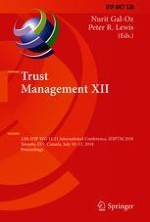This book constitutes the refereed proceedings of the 12th IFIP WG 11.11 International Conference on Trust Management, IFIPTM 2018, held in Toronto, ON, Canada, in July 2018.
The 7 revised full papers and 3 short papers presented were carefully reviewed and selected from 22 submissions. The papers feature both theoretical research and real-world case studies and cover the following topical areas: trust in information technology; socio-technical, economic, and sociological trust; trust and reputation management systems; identity management and trust; secure, trustworthy and privacy-aware systems; trust building in large scale systems; and trustworthyness of adaptive systems. Also included is the 2018 William Winsborough commemorative address.
